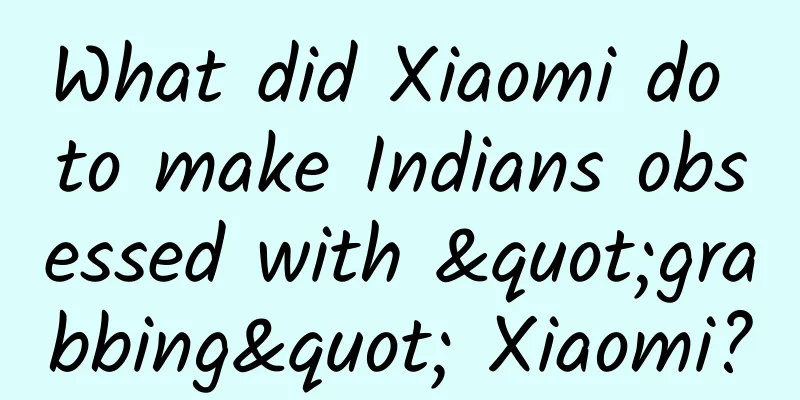What did Xiaomi do to make Indians obsessed with "grabbing" Xiaomi?

|
Last year, Lei Jun, the founder of Xiaomi, announced that he would invest $1 billion in 100 mobile app startups in India in the next five years. Behind this is the importance that Xiaomi and Lei Jun attach to the Indian market, and of course, it is also because of the huge success Xiaomi has achieved in the Indian market. Xiaomi, which entered India in 2014, even beat Samsung. Samsung, which had been firmly in the lead, faced a step-by-step approach from Xiaomi in the second half of 2017. Xiaomi officially became the No. 1 smartphone brand in India since the fourth quarter of last year. According to statistics from market research firm IDC, Xiaomi's market share in India in the first quarter of this year was as high as 31.1%, confirming its advantage over Samsung. How exaggerated is Xiaomi's growth? It has increased 35 times in 2 years. In the third quarter of 2014, 100,000 units were sold, and in the third quarter of 2016, more than 3.5 million units were shipped. How did Xiaomi achieve this in just two years? Focus on second- and third-tier cities First, Xiaomi's marketing strategy in India has been full of surprises. Unlike its competitors OPPO and vivo, which focus their resources on first- and second-tier cities and vigorously implement a signboard poster promotion strategy, Xiaomi still focuses on the online mobile phone market, but also pays attention to TV and newspaper advertising, as well as the key disruptive price. Xin said that Xiaomi is usually 30% cheaper than OPPO for mobile phones of the same specifications, which is why it often triggers rounds of rush purchases by Indian consumers. How crazy is it? As soon as Xiaomi's advertisement came out, many Indian consumers flocked to mobile phone stores to inquire about it. However, Xiaomi's sales channel was online, forcing dealers to buy Xiaomi online and resell it at a higher price, and consumers still had to pay for it. Xiaomi spends the most marketing resources in third- and fourth-tier cities, because they have the largest number of low- and middle-income consumers, and cost-effectiveness is the most important to them. Local Manufacturing Second, in order to reduce costs and respond to India's manufacturing policy, Xiaomi has cooperated with Foxconn since 2015 to establish a production base in the southeast and now has 6 assembly plants in India. According to Xiaomi India data, 95% of Xiaomi phones sold in India are locally manufactured. As of the third quarter of this year, almost 100% of mobile phone circuit boards and assembly were completed in India. As the Indian government raises import tariffs on the mobile phone industry chain, the advantages of Indian manufacturing will become more and more obvious. In order to encourage the development of the electronics manufacturing industry, the government has changed from free import tariffs to at least 10% tariffs on mobile phone circuit boards since April this year, and the import tariff on complete devices has been raised from 10% to 20%. The increase in tariffs will accelerate the establishment of more mobile phone manufacturers in India, including Samsung and Apple. In addition, he also pointed out that Made in India offers export benefits. Mobile phones made in India are also expected to be exported to other countries, making India the next production base for multinational mobile phone brands. Online sales + physical store consumption Third, at the end of 2016, the Indian government announced the abolition of banknotes without warning, which also boosted Xiaomi. The abolition of banknotes led to a surge in the number of people applying for credit cards, and Xiaomi mainly promoted online purchases, resulting in a surge in the number of new Xiaomi users in a short period of time. At the same time, due to the particularity of the Indian market, Xiaomi has also adjusted its strategy of only selling online in other markets. Starting in 2017, Xiaomi India began to move offline in a big way, first opening the first "Mi Home" in Bangalore, India. At that time, it caused a sensation in the city, with an average of one Xiaomi phone sold per second. Today, there are 36 Mi Homes in India, and three Mi Home flagship stores. In addition, Xiaomi has tailored its offline sales strategy: Xiaomi Preferred Partner Stores - mobile phone stores that display multiple brands of mobile phones and place Xiaomi phones in prominent positions. There are now 2,500 Preferred Partner Stores across India, and Xiaomi has also cooperated with large mobile phone chain stores to cater to the Indian market's consumer habits of preferring physical stores. It is these three strategies that have made Xiaomi thrive in India, defeating Samsung to become the No. 1 in India, and also rising strongly in Southeast Asia, beating Vivo and OPPO to two years of defeat. The reason is that Lei Jun said at the Xiaomi 8th Anniversary Conference: Xiaomi wants to make good products that touch people's hearts and are reasonably priced, especially for ordinary consumers. Xiaomi has undoubtedly achieved this. As a winner of Toutiao's Qingyun Plan and Baijiahao's Bai+ Plan, the 2019 Baidu Digital Author of the Year, the Baijiahao's Most Popular Author in the Technology Field, the 2019 Sogou Technology and Culture Author, and the 2021 Baijiahao Quarterly Influential Creator, he has won many awards, including the 2013 Sohu Best Industry Media Person, the 2015 China New Media Entrepreneurship Competition Beijing Third Place, the 2015 Guangmang Experience Award, the 2015 China New Media Entrepreneurship Competition Finals Third Place, and the 2018 Baidu Dynamic Annual Powerful Celebrity. |
<<: Why is it said that new energy vehicles will definitely be led by China?
Recommend
Table tennis teaching course video collection
Course Catalog: ├──05-shakehandloop-attack.mp4 1....
What kind of phenomena did the "eyewitnesses" discover before the Wenchuan earthquake? Are earthquakes really unpredictable?
Hello everyone, today I, the editor from Sichuan,...
Why is Qinling Mountains called the “Central Water Tower”?
The Qinling Mountains unite the north and south a...
Types and development trends of WeChat Moments ads in 2015: H5 ads become popular on the platform!
Since last year, WeChat has become a social platf...
Will there ever be a day when all QR codes are used up?
Author: Wang Rifang Reviewer: Chen Xudong With th...
The past, present and future of fire extinguishers
Fire extinguisher is the most important tool for ...
Optimize 200 series AMD releases the latest 15.7 WHQL driver
AMD has released the latest graphics card catalys...
China Association of Automobile Manufacturers: China's new energy vehicle market fell by about 4.0% in 2019
According to the China Association of Automobile ...
[Collection] A complete collection of essential tools for ASO optimization, some ASO optimization and analysis tools worth recommending!
1. ASO 100: http://aso100.com/ Competitive ASO co...
Are luxury goods suitable for TikTok marketing? ?
Last week, TikTok officially announced that its g...
A complete list of short video operation content models
Recently, many friends have sent me private messa...
Sony WH-H800 is better than Beats headphones, which allows you to have both good looks and high sound quality
As the ability of music playback devices, mainly ...
10 steps for event operation!
This time, we have combined some examples in the ...
Sharing practical tips on Douyin promotion and operation!
During this period, Tik Tok has become popular an...
Information flow advertising | Learn the correct method to increase exposure!
My friends, I believe many of you are worried abo...





![[Precise selling points + excellent creativity] The financial industry will win by promoting like this!](/upload/images/67cc2ad563432.webp)



